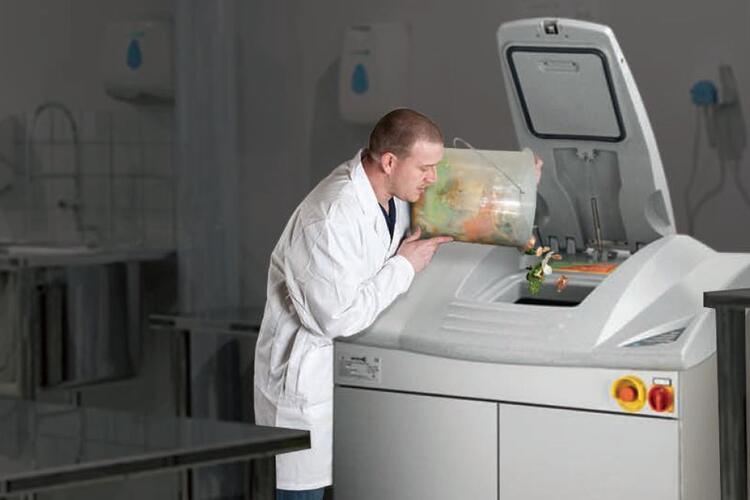Savills Launches Food Waste Digesters at Princesshay
17 February 2016Savills Launches Food Waste Digesters at Princesshay
17 February 2016At Princesshay Shopping Centre in Exeter, managing agent Savills and asset manager The Crown Estate have installed three food waste digesters, significantly increasing recycling, cutting disposal costs for occupiers and reducing environmental impacts. Following the success of this initiative, Savills is considering food waste digester opportunities for other sites in England.
Key Facts
- 100% OF WASTE DIVERTED FROM DIRECT-TO-LANDFILL, WITH 90% RECYCLING
- £12,250 ANNUAL SAVINGS ON FOOD WASTE DISPOSAL
- PAYBACK ON FOOD WASTE DIGESTERS WITHIN THREE YEARS
- 232 TONNES OF FOOD WASTE RECYCLED ANNUALLY
Situation
Savills Commercial Property Management team manages over 2,600 commercial properties throughout Europe on behalf of clients, taking a considered and structured approach to managing environmental impacts.
Savills is managing agent for Princesshay Shopping Centre in Exeter city centre, a 49,000 m2 retail and leisure scheme owned jointly by The Crown Estate and TH Real Estate. The Crown Estate acts as the asset manager for the joint venture.
Like many UK shopping centres, Princesshay has diverted 100% of waste from direct-to-landfill for several years. The Savills site team had achieved relatively high recycling rates through occupier engagement and on-site segregation. Any residual waste was sent for incineration with energy recovery.
In 2013, the team identified that, following a rise in leisure activities at Princesshay, there was an increase in food and drink based waste, accounting for 25% of all waste at the Centre. This waste is very wet and heavy, and so is costly to dispose of. At the time, it was sent to an energy recovery facility for incineration, with annual disposal costs of £16,000.
Actions
Savills evaluated the commercial and environmental returns of introducing a food waste digester on site. When the team approached The Crown Estate with its proposal, it was agreed that three food waste digesters would be installed at Princesshay, so that all food waste could be handled on site.
Food waste digesters use enzymes to breakdown the food into grey water, which can then easily be returned direct to the local water supply via the foul drain. The solution chosen for Princesshay was the Waste2O, manufactured by Mechline. These convert up to 180 kg of food waste to grey water over a 24-hour period. Each digester is 1.1m wide by 1.3m high, about the size of an industrial washing machine.
In launching and implementing the new food waste recycling scheme, the Savills site team was able to build on several years’ engagement with occupiers on waste management. They discussed the new food waste recycling scheme during quarterly occupier meetings, updated the occupier Recycling Handbook, continued monthly store prizes for the best occupier recycler and added information on food waste to the recycling notices on wheelie bins, in kitchens and in other back of house areas.
In addition, retailers at Princesshay were already in the habit of segregating glass, cardboard, paper, plastic, metal and timber waste, and so food waste was a logical progression of an existing strategy. Each retailer was provided with buckets for food waste recycling, with clear notices identifying what could be processed and what could not. The buckets are about the size of a standard household bucket and transparent so that the team can spot items that the machines would not be able to digest.
Financials and Benefits
- Investment of £27,900 including installation of water supply, electricity supply and water heaters
- Annual savings of £12,250 based on:
- £3,750 annual running costs for enzyme packs, plastic chips, water, electricity and staff costs
- £16,000 annual savings on fees historically paid for food waste management, covering transport, processing costs and bin rental
- Payback within three years, with ongoing savings thereafter
- 232 tonnes of food waste recycled annually
- Reduced carbon footprint, with the on-site food waste digesters eliminating the need for collection and transportation of food waste to processing sites
- Low maintenance and easy to use, providing a clean, odour free and cost saving solution for food waste disposal.
Challenges and Achievements
PLANNING
How to evaluate the feasibility of food waste digesters?
The Savills team started by evaluating the financial and environmental returns on installing a food waste digester at Princesshay. These are largely driven by the volume, type and location of food waste produced and processed on site. The team also looked at staffing implications, including who would be responsible for transferring the segregated food waste from the retailers to the digester. Savills agreed with retailers that the site waste management team would collect and centralise food waste for most shops and restaurants, except for a couple of retailers located near the food waste digesters. After identifying the preferred food waste digester, Savills prepared a suitable location, where the equipment would be covered and they could install electricity supply to power the machines, warm water supply for the digestive enzymes to survive and a foul drain connection for the greywater that is discharged.
OPERATION
How to extract maximum value from the food waste digesters?
Food waste digesters are most effective if they are regularly fed, as then they can process more waste and deliver greater value. The digesters at Princesshay can each be fed a maximum of 45 kg every six hours. The waste management team feeds the digesters every three hours during the day, with the final feed taking place just before the site closes in the evening and the next feed happening as soon as the Centre opens in the morning. This enables the team to process all the food and drink based waste segregated at Princesshay. If more food waste was produced, the team could look at options to introduce additional feeds out-of-hours.
CONTAMINATION
How to reduce contamination?
The Centre Manager at Princesshay has successfully engaged with store managers to gain their buy-in for the project and ensure that they recognise the important role they each play and understand that the digesters can only process soft organic food. The simple message “If you can eat it, the machine can process it” is communicated through the Recycling Handbook, quarterly meetings, store visits and on notices provided to help store managers educate their teams. Ongoing communications are important as retail outlets can have a relatively high turnover of staff. Buckets of contaminated food waste are returned to the retailer and the message is reiterated, “If you can eat it, the machine can process it”. For all waste streams, including food waste, a ‘carrot and stick’ approach has helped ensure the strategy is implemented by all, with monthly prizes for the best occupier recycler and additional charges for retailers who contaminate waste streams.
Find out more
Lizzie Jones
Sustainability Manager
Savills
www.savills.com
*Please note that the information on this page was supplied by the BBP Member and the BBP assumes no responsibility or liability for any errors or omissions in the content



